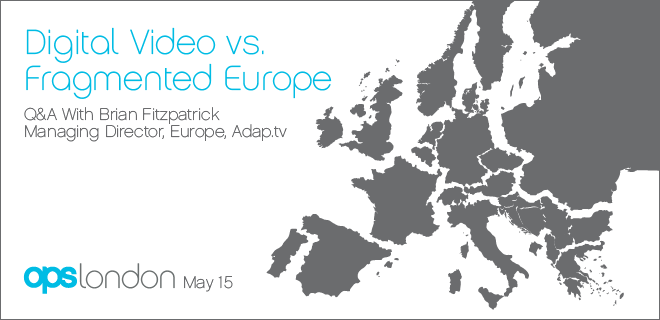
I don’t want to make anyone faint from shock, but did you know this European Union thing is actually made up of a whole bunch of different countries, most with different langauges? You’ve got some pretty divergent markets, and this fragmentation makes online video advertising painful for publishers stretched across the EU.
Never fear, says Brian Fitzpatrick, Managing Director, Europe for Adap.tv – solutions are out there. Before his appearance on the future of video panel at OPS London (Tuesday, May 15!), Brian shared with us thoughts on the growing landscape of video RTB and private marketplaces, as well as how the e-Privacy Directive will affect advertisers’ ability to target video audiences.
What are publishers’ biggest challenges to monetising online video Europe? What are the hurdles to adoption of video RTB?
Monetising online video is not really a challenge, as the lack of supply means that most publishers see very high fill rates and good CPMs.
However, European publishers are faced with fragmentation, with each country being an individual market. A publisher in Germany wanting to sell inventory in the UK, for example, may not have the right contacts to make this straightforward. They will need to research relevant media planners and buyers before negotiating a price and putting the campaign live, after which they need the facility to track and centralise the frequency of campaigns to avoid ad repetition. Again, this is challenging when working across several countries.
Adap.tv’s technology sets out to ease these marketing headaches. Our Marketplace is the world’s largest source of video advertising supply and demand, so publishers have easy access to the right buyers at the right time. In addition, the programmatic approach of our Platform delivers an automated and unified way to manage online video campaigns in real time.
RTB began life in the display world as a way to monetise remnant inventory, so it has a reputation for trading media at a low cost. Therefore, one of the hurdles is for premium publishers to be comfortable that with RTB, when supply is low and demand high, they can get higher prices. This was demonstrated in December 2011, when we saw a 30% increase in prices due to the high competition for inventory.
How about on the agency side – what are the chief difficulties in executing video ad campaigns, particularly when it comes to reaching audiences through RTB?
The predominant issue faced by agencies is the skillset required. As media evolves from an art to a science, all the major agencies are recruiting people into their trading desks who already have the technical skills to complement their planning departments.
What factors differentiate the European video market from others such as the United States? What must be considered when building a strategy?
Once again, the key differential is that of fragmentation, so it is almost impossible to take a model that has been developed to work well in the US and overlay it across the whole of Europe. The TV industry in particular is quite country specific in Europe due to language and, with two to four dominant players in each market, it is very difficult to plan campaigns centrally.
In contrast, in the US, a single currency, dominant language and a fairly similar culture make it far easier to create a single strategy at scale.
How does a European “private marketplace” for online video work and what are the advantages?
A Private Marketplace is a platform that allows publishers, advertisers and agencies to connect with each other directly.
If a publisher from one market lists their inventory, then buyers from other markets can have visibility on this inventory giving them much more clarity on what they are buying and where and importantly at what price.
At the same time, private video ad marketplaces also benefit the buy side because they provide the pre-selected advertisers and agency partners with a new way to access premium, brand safe VOD inventory. They can do this using their own tools with a privately labeled self-service console.
Video ads tend to bring in higher CPMs, but will the proliferation of programmatic buying of video (RTB in particular) encourage media buyers to snatch low-priced inventory on premium sites?
Not necessarily – again it is a supply and demand issue. RTB gives premium publishers control over the floor prices so they can avoid their inventory being reduced in price. In other words, RTB gives publishers more flexibility in managing their yield.
How do you see the EU privacy directive affecting the ability of European advertisers to reach and publishers to sell targeted video audiences?
The concern is that the ePrivacy directive will create a two-speed development within our industry. Companies that operate outside Europe will continue to innovate while businesses that have to comply with a directive that has been interpreted so differently by many member states will stagnate.
Our industry is dominated by forward thinking US companies, so there is also a risk that much of Europe’s top talent will simply gravitate to countries where they can work in an environment that allows them to develop without these constraints.
It seems harsh and short-sighted that an industry like ours that is in the early stage of its development and changing rapidly is being asked to comply with laws that could be out of date in years if not months.
 |
Get the latest on all things premium at OPS London, which will bring EU digital advertising leaders and ops professionals together to discuss and develop best practices for operational excellence. Register today for OPS London, which will be held May 15, 2012. |